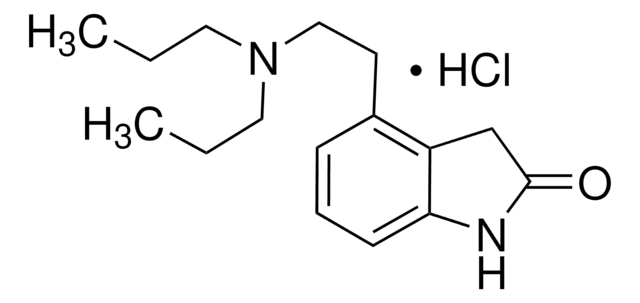C0246
Cabergoline
≥98% (HPLC)
Sinónimos:
1-Ethyl-3-(3′-dimethylaminopropyl)-3-(6′-allylergoline-8′β-carbonyl)urea, 1-[(6-Allylergoline-8β-yl)carbonyl]-1-[3-(dimethylamino)-propyl]-3-ethylurea, Cabaser, Dostinex, FCE-21336
About This Item
Productos recomendados
Análisis
≥98% (HPLC)
formulario
powder
actividad óptica
[α]/D −63 to −74°, c = 0.5 in dichloromethane
solubilidad
DMSO: ≥10 mg/mL
emisor
Johnson & Johnson
temp. de almacenamiento
2-8°C
cadena SMILES
CCNC(=O)N(CCCN(C)C)C(=O)[C@@H]1C[C@H]2[C@@H](Cc3c[nH]c4cccc2c34)N(CC=C)C1
InChI
1S/C26H37N5O2/c1-5-11-30-17-19(25(32)31(26(33)27-6-2)13-8-12-29(3)4)14-21-20-9-7-10-22-24(20)18(16-28-22)15-23(21)30/h5,7,9-10,16,19,21,23,28H,1,6,8,11-15,17H2,2-4H3,(H,27,33)/t19-,21-,23-/m1/s1
Clave InChI
KORNTPPJEAJQIU-KJXAQDMKSA-N
Información sobre el gen
human ... DRD2(1813)
¿Está buscando productos similares? Visita Guía de comparación de productos
Acciones bioquímicas o fisiológicas
Características y beneficios
Palabra de señalización
Warning
Frases de peligro
Consejos de prudencia
Clasificaciones de peligro
Acute Tox. 4 Oral - Lact.
Código de clase de almacenamiento
11 - Combustible Solids
Clase de riesgo para el agua (WGK)
WGK 3
Punto de inflamabilidad (°F)
Not applicable
Punto de inflamabilidad (°C)
Not applicable
Certificados de análisis (COA)
Busque Certificados de análisis (COA) introduciendo el número de lote del producto. Los números de lote se encuentran en la etiqueta del producto después de las palabras «Lot» o «Batch»
¿Ya tiene este producto?
Encuentre la documentación para los productos que ha comprado recientemente en la Biblioteca de documentos.
Nuestro equipo de científicos tiene experiencia en todas las áreas de investigación: Ciencias de la vida, Ciencia de los materiales, Síntesis química, Cromatografía, Analítica y muchas otras.
Póngase en contacto con el Servicio técnico








